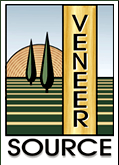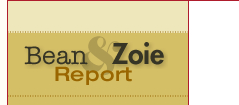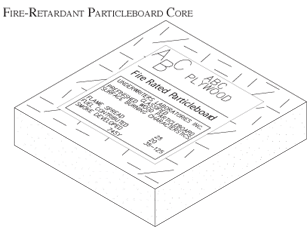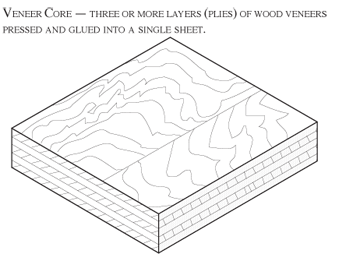







There are a wide range of core materials available for the fabrication of architectural woodwork. The primary core materials are covered in this standard as follows.
INDUSTRIAL GRADE PARTICLEBOARD CORE — WOOD PARTICLES OF VARIOUS SIZES THAT ARE BONDED TOGETHER WITH A SYNTHETIC RESIN OR BINDER UNDER HEAT AND PRESSURE.
Medium Density Industrial Particleboard is used in the broadest applications of architectural woodwork. It is especially well suited as a substrate for high quality veneers and decorative laminates.
When used as panels without any surface plies, the product is referred to as particleboard. When used as an inner core with outer wood veneers, the panel is referred to as particle core plywood. Industrial particleboard is commercially classified by “density,” which is measured by the weight per cubic foot of the panel product.
- Low Density [LD series] = generally less than 640 kg per m3 (40 pounds per ft3)
- Medium Density [M series] = generally between 640-800 kg per m3 (40-50 pounds per ft3)
- High Density [H series] = generally above 800 kg per m3 (50 pounds per ft3). Rarely used for woodwork.
 MOISTURE RESISTANT PARTICLEBOARD CORE
MOISTURE RESISTANT PARTICLEBOARD CORE
Some Medium Density Industrial Particleboard is bonded with resins more resistant to swelling when exposed to moisture. The most common grades are ANSI 208.1-1999 Type M-2-Exterior Glue and M-3-Exterior Glue. Availability to the architectural woodworker is limited in some markets.
Some Medium Density Industrial Particleboard has been treated during manufacture to carry a UL stamp for Class I fire rating (Flame spread 20, Smoke developed 450). This material is often used as a substrate for paneling requiring a Class I rating. Fire-retardant Medium Density Fiberboard is also available in some markets.
MEDIUM DENSITY FIBERBOARD (MDF) CORE — WOOD PARTICLES REDUCED TO FIBERS IN A MODERATE PRESSURE STEAM VESSEL, COMBINED WITH A RESIN, AND BONDED TOGETHER UNDER HEAT AND PRESSURE.
Due to the finer texture of the fibers used in manufacturing Medium Density Fiberboard (MDF) it is smoother than Medium Density Particleboard. The uniform texture and density of the fibers create a homogenous panel that is very useful as a substrate for paint, thin overlay materials, veneers and decorative laminates. MDF is among the most stable of the mat-formed panel products. When used as an inner core with outer wood veneers, the panel is referred to as MDF core plywood.
MOISTURE RESISTANT MDF CORE
Some MDF is made to meet the ANSI 208.2-2002 reduced thickness swell criteria. Availability to the architectural woodworker is limited in some markets.
VENEER CORE — THREE OR MORE LAYERS (PLIES) OF WOOD VENEERS PRESSED AND GLUED INTO A SINGLE SHEET.
 What many think of as traditional “plywood,” a panel made up of alternating layers of thin veneers, is called veneer core. Adhesive is placed between the veneer layers, and the panels are assembled under heat and pressure until the adhesive is set. The two outside layers of veneer are often selected for species, grain, and appearance; and are called the “face veneers.”
What many think of as traditional “plywood,” a panel made up of alternating layers of thin veneers, is called veneer core. Adhesive is placed between the veneer layers, and the panels are assembled under heat and pressure until the adhesive is set. The two outside layers of veneer are often selected for species, grain, and appearance; and are called the “face veneers.”
COMBINATION CORE - A BALANCED BLEND OF PARTICLEBOARD OR FIBERBOARD WITH VENEER LAYERS.
A combination of veneer core and particleboard/fiberboard core technologies, utilizing some of the advantages of each. This material should be evaluated and approved by the customer. Many products will meet these standards.
HARDBOARD CORE - HARDBOARD IS DEFINED AS INTER FELTED FIBERS CONSOLIDATED UNDER HEAT AND PRESSURE TO A DENSITY OF 500 KG PER M3 (31 POUNDS PER CUBIC FOOT) OR GREATER.
Often used for casework backs, drawer bottoms, and divider panels, hardboard is available with either one side (S1S) or two sides (S2S) smooth. There are typically two types of hardboard core used by architectural woodworkers: Standard (untempered) and Tempered, which is standard hardboard subjected to a curing treatment increasing its stiffness, hardness, and weight.
... that managed forests, thanks to their high proportion of young, strong, growing trees, enable CO2 to be extracted?
... that an old, unmanaged forest produces as much CO2 through processes of decomposition and decay as it stores, and that therefore an unmanaged forest contributes nothing to reducing global CO2?

Phone: 407-423-2252 • Fax: 407-423-1566 • sales@veneersource.com